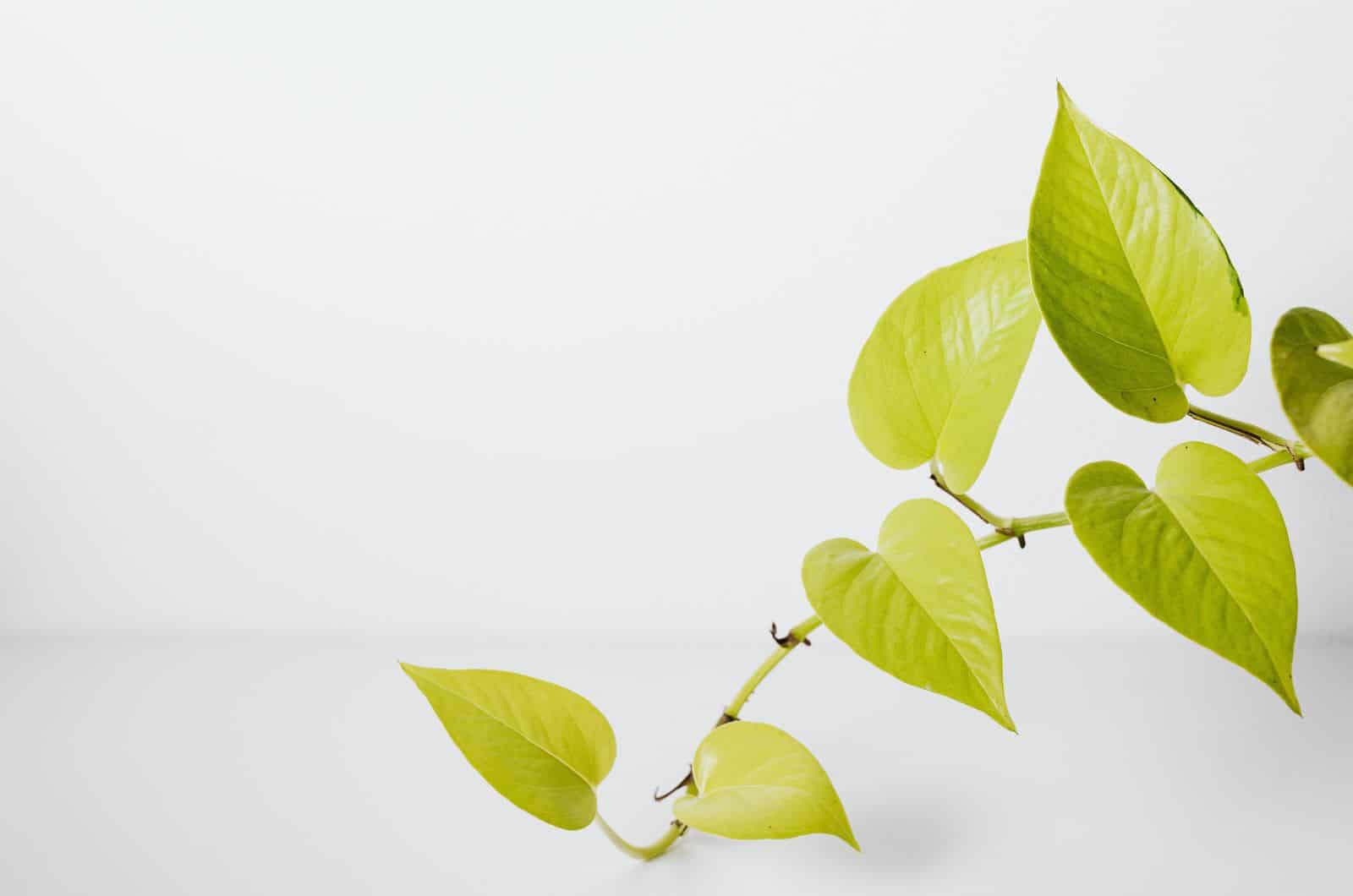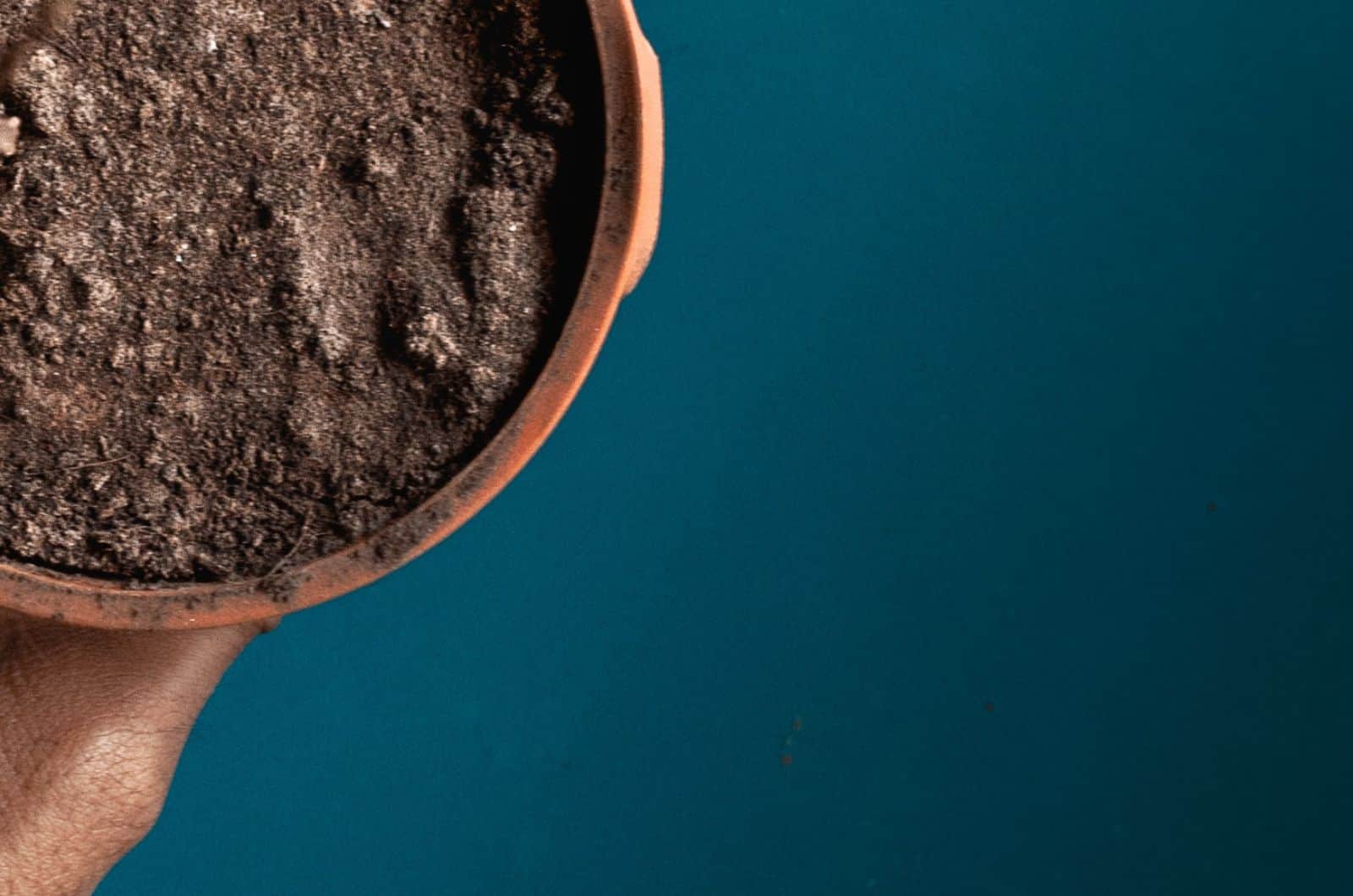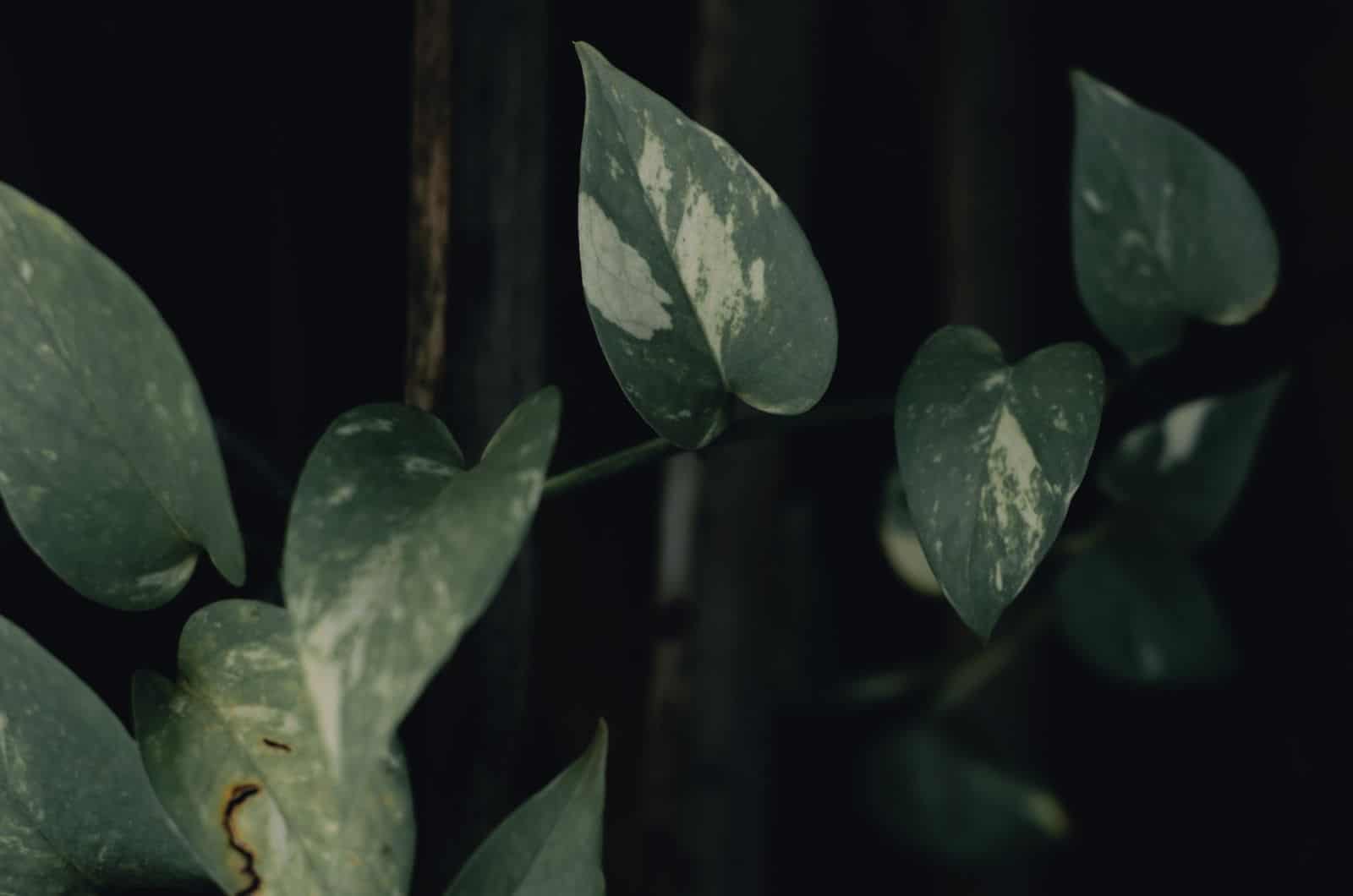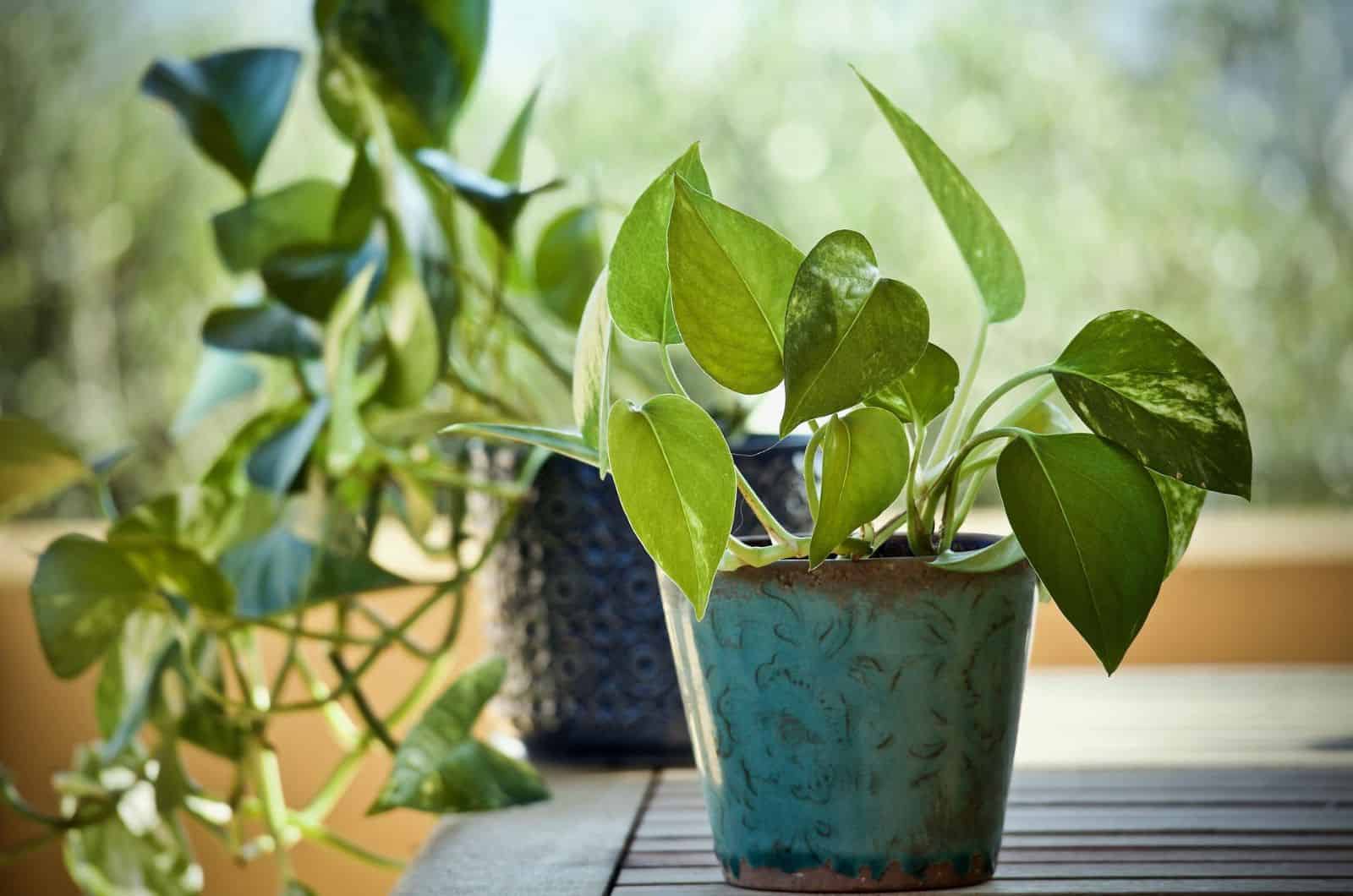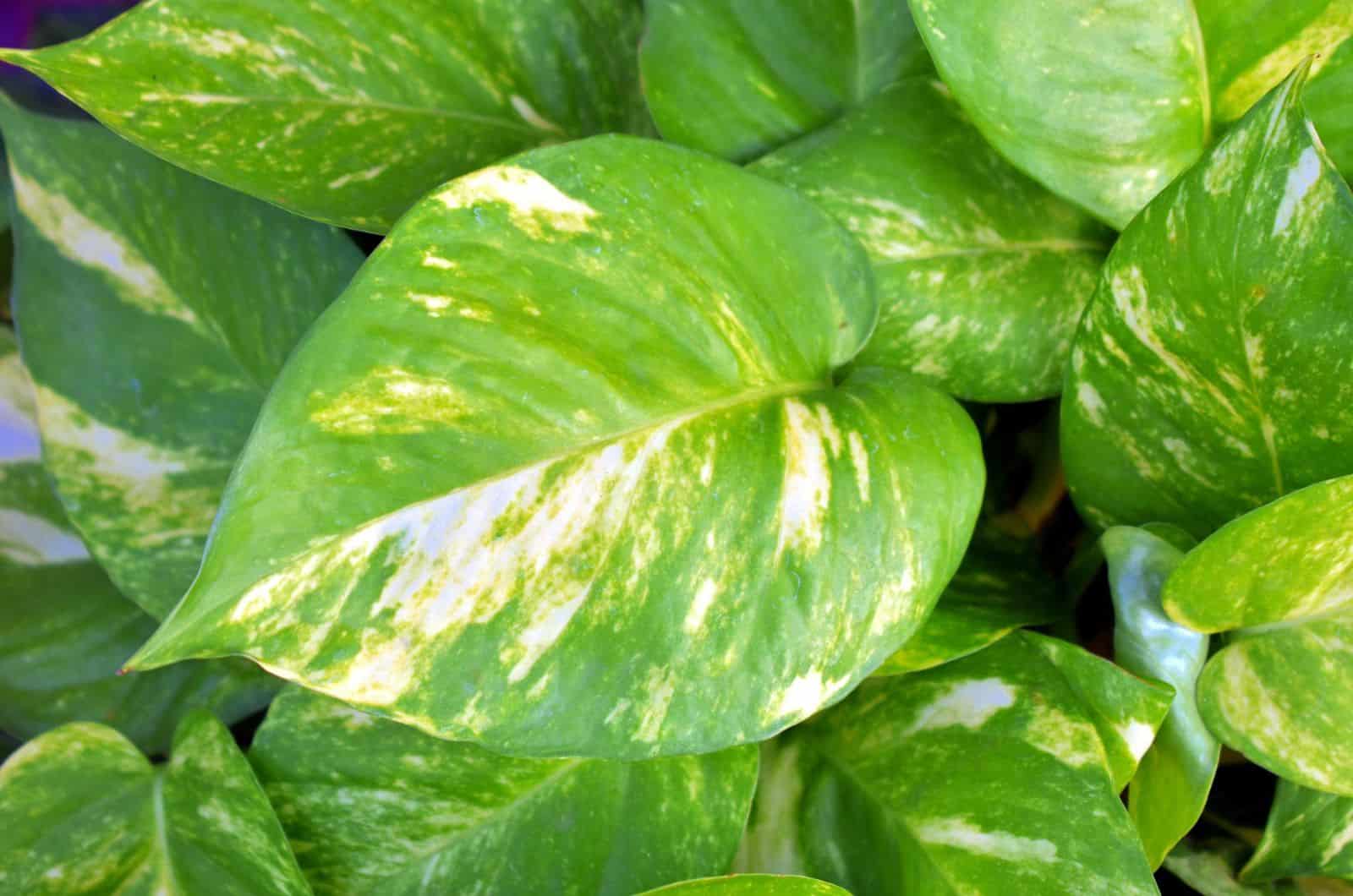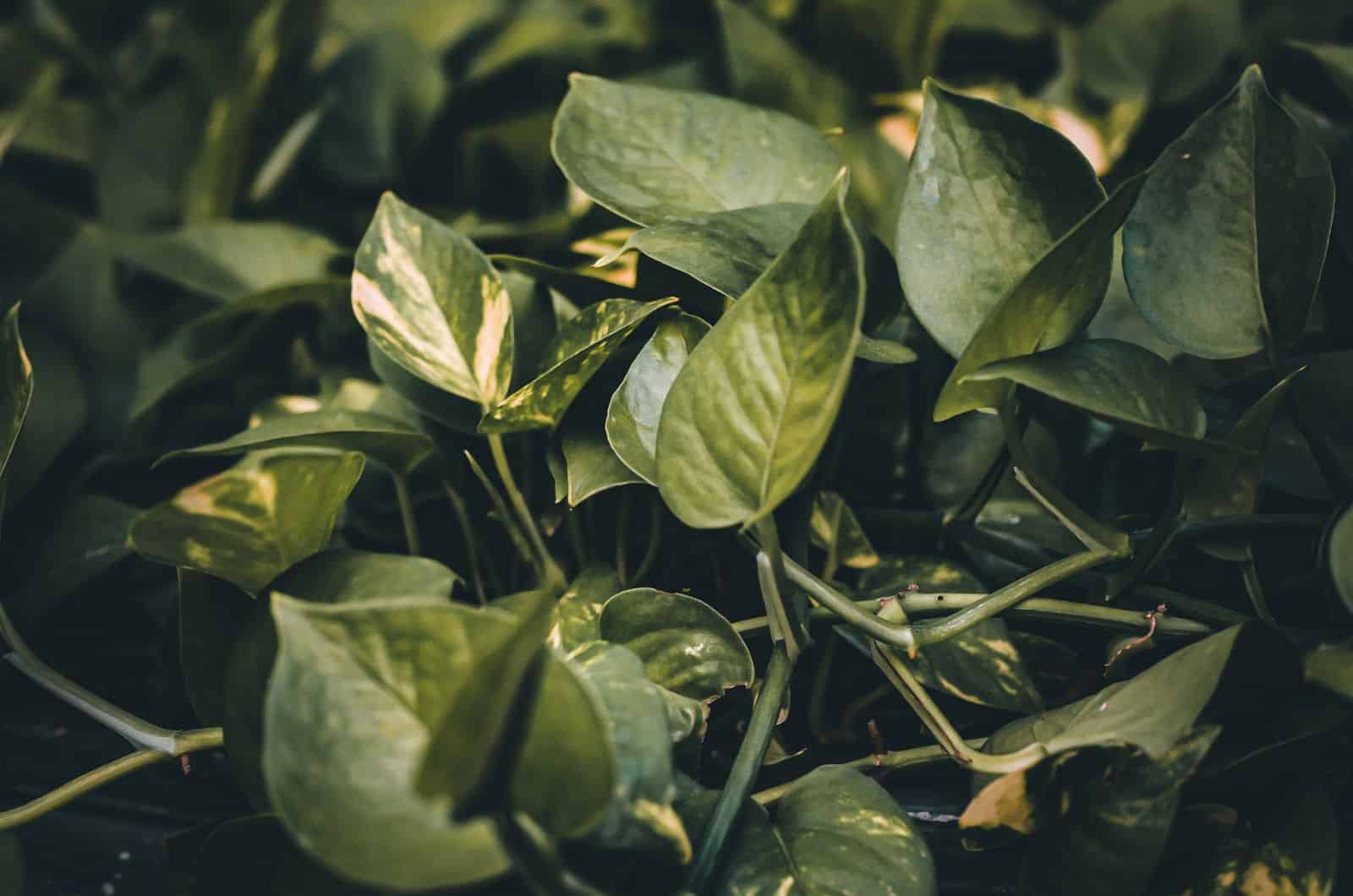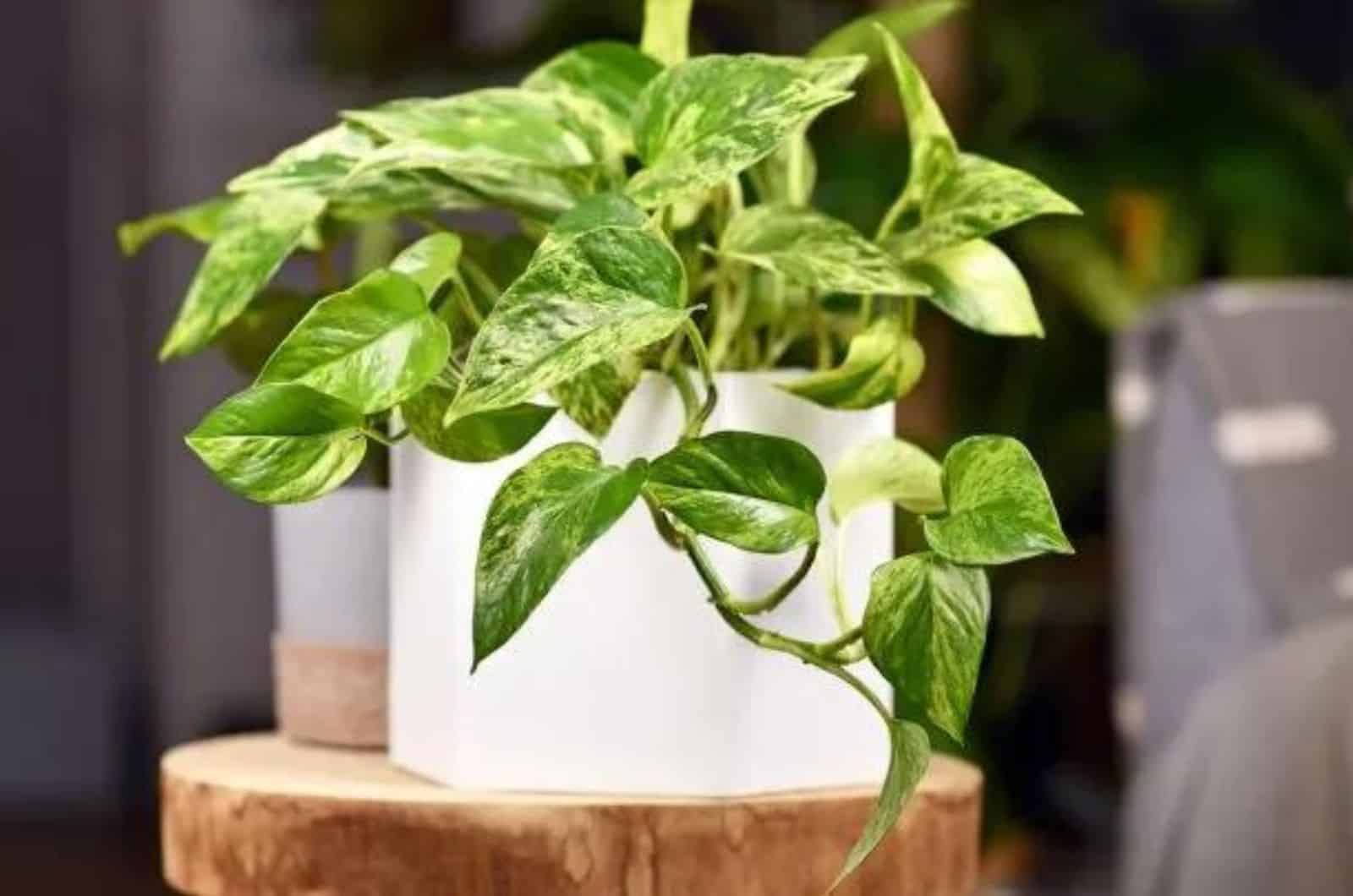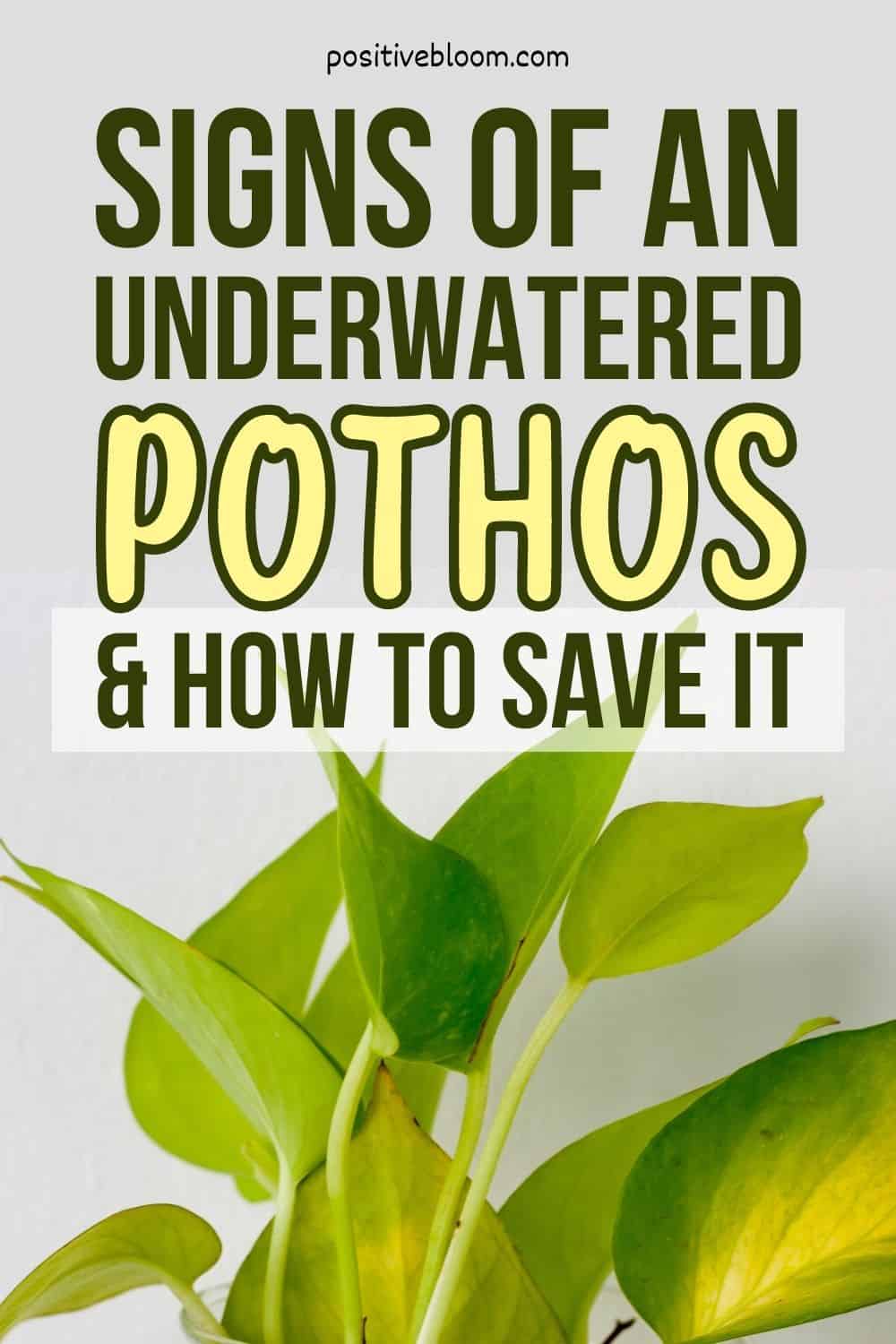Sometimes you may forget to water your houseplants — don’t worry, this can happen to anyone!
Maybe you went on a short notice vacation and forgot all about your houseplants, or you are just having a couple of bad weeks and watering your Pothos is the last thing on your mind. Trust me, we’ve all been there.
Once you notice that your precious Pothos isn’t looking good, you may be wondering if there is any way to save it.
All is not yet lost, and there are plenty of ways to save an underwatered Pothos. Should you water the plant immediately, or maybe repot it first?
Read on to find out how to save an underwatered pothos plant!
Signs Of An Underwatered Pothos
Both overwatering and underwatering manifest similarly, but I’m sure that you know whether you’ve been constantly watering your precious plant or if you have skipped a few waterings!
The first thing that you should check to distinguish between an underwatered and overwatered pothos plant is the soil — if the soil is bone dry, you know that you are dealing with underwatered pothos. On the contrary, wet soil is an obvious sign of overwatering.
Let’s take a look at some signs of an underwatered pothos!
1. Dry Soil
As we mentioned before, if the soil of your Pothos plant is bone dry then you are probably dealing with underwatering. If you have watered your plant and the soil dries out quickly, then the plant must have been underwatered.
Dry soil will also start crumbling and look more compact. If the soil is left in this condition for too long then a waxy coating will form, which prevents the soil from properly absorbing water.
In this case, you should repot your pothos plant and organize a new watering schedule!
2. Droopy Leaves & Wilting
Leaves are like the face of your plant, so if you notice that they look kind of pale there’s definitely something going on with it!
Whenever your indoor plants aren’t getting enough water, they will start to wilt and look lifeless. Luckily, this is easily fixed by watering pothos!
On the contrary, if a plant is drooping due to overwatering it might be harder to fix because the culprit is likely root rot. In this case, you will have to repot your pothos and cut off any damaged or mushy roots.
3. Yellow Leaves
The bottom leaves of a completely dried-out plant will frequently begin to yellow. There are numerous reasons the leaves of pothos plants can turn yellow. Even so, you might be able to tell if the yellowing was caused by overwatering by looking at the age and positioning of the leaves.
The elder leaves nearest to the soil should be examined first because Pothos roots supply food and water to the leaves, which should be distributed first to the lower leaves.
Naturally, if the root system stops functioning they will be unable to convey any signals, which causes the leaves to turn yellow. Eventually these leaves may turn brown if not treated properly.
4. Brown Spots
Brown spots on pothos leaves have a variety of common causes, just like yellow leaves. For instance, fungi, low humidity, sunlight and bugs are all potential causes of brown spots.
However, if you notice these kinds of spots I strongly advise checking the amount of moisture in the plant’s soil first, because any discoloration and spotting usually indicates inadequate watering.
In case of overwatering, the plant starts to drown in excess water, which causes the cell to swell and blisters to form. Pothos leaves develop brown lesions as the blisters appear. According to science, this means that your pothos plant is dealing with a leaf edema on the undersides of the leaves.
5. Brown Leaves
We mentioned before that yellow leaves will soon turn brown if you don’t fix the watering issues. First, brown tips on the leaves will appear and the leaves will look wrinkly and crispy. These are the usual signs of damaged leaves.
The entire leaf will eventually turn brown, and it’s now as good as dead.
It is always recommended to remove any dead leaves, especially in case of discoloration, which indicates pest infestations and diseases. By removing the affected leaves, you will prevent them from spreading.
6. Soil Pulling Away
Once there is insufficient moisture in the potting soil, it will start to compact. Due to this compactness, the soil will look like it is slowly pulling away.
This happens because of a prolonged period of time between watering sessions. If you still want great soil for your potted plant, find the perfect watering schedule (you can look for tips and tricks down below!).
7. Pothos Leaves Curling
We often fear overwatering our plants, however, skipping a few watering sessions can be just as bad. Pothos leaves curling might be from both overwatering and underwatering, though it’s underwatering in most cases.
Though the pothos leaves do curl and dehydrate in both scenarios, if underwatering is the source of the problem there isn’t enough water for the soil or pothos roots to send to the leaves.
On the other hand, too much water causes pothos roots to die, which also prevents them from supplying water to the leaves.
It may be possible to determine whether there are watering problems if the curling is going in the direction of the leaves.
The leaves of the pothos will curl downward if it is overwatered.
According to science, underwatering a plant causes it to lose its turgor, a biological element that gives pothos plant tissue its rigidity. The leaf begins to curl when the tissue isn’t rigid.
The leaves are curling as a response to the water deficiency, i.e., to preserve water for later.
Pothos plants may grow in a variety of environments, even without water. However, if they don’t get water they won’t keep their healthy leaves and the heat will force them to lose water even more, which will make the leaves curl.
This mostly happens in the summer when the lack of water and extreme heat causes plants to become increasingly thirsty and dry up.
For a plant to flourish and maintain its viability, water is a must. To prevent soil dryness, pothos plants also need regular irrigation.
Underwatering vs Overwatering
Now that you are aware of the signs of underwatering, it is time to learn the signs of overwatering.
You need to be able to distinguish between them because you don’t want to add extra water to previously soaked soil, but at the same time you also don’t want to drain a pothos that is already dehydrated.
The color of the leaves may be the first indication that you are overwatering. Overwatering can also result in yellowing of the foliage, similarly to underwatering.
However, the leaves will also be dry and begin to droop if the plant is dehydrated.
Your pothos will exhibit stunted development, wither, and eventually die off if you don’t give them water for an extended length of time.
If you are giving your Devil’s ivy too much water, it will become waterlogged and the roots won’t be able to absorb nutrients and oxygen. This basically means that too much water can suffocate your plant.
With overwatering, there is also another silent but deadly killer known as root rot.
What Is Root Rot?
Root rot is a common sign of overwatering, no matter whether it’s with outdoor or indoor gardening. Only a few species of plants can thrive in soggy soil, which is generally disliked by plants.
Pothos is not a plant that thrives in extremely damp soil. Even a brief period of damp can result in irreversible damage.
Root rot is a fungal disease that is difficult to detect because the roots suffer the consequences of too much water in the soil first.
Unhealthy roots are the start of many other problems. Everything in the plant begins at the roots, and strong roots are essential for new growth.
The roots of pothos plants supply the leaves and stem with the nutrients they need to flourish.
The soil’s structure provides the air gaps required for ventilation. Although it may seem surprising, roots require oxygen for optimum activity. Extra water enters the air pockets and clogs, which fully prevents the flow of oxygen and eventually suffocates the plant.
In addition to this, soggy soil attracts fungus that attacks roots and completely destroys the root ball of your plant. In this case, repotting is necessary and you will have to prune mushy and damaged roots and also put your plant in a new pot with new soil that doesn’t contain any traces of fungus.
How Can I Tell If The Soil Is Getting Either Too Much Or Not Enough Water?
The best thing to do if you’re not sure what caused the damage to your pothos is examine the soil’s moisture content.
There are a few ways to determine whether the soil needs more or less water.
Let’s begin with the simplest way, which only requires your eyes. Check the pothos soil’s color – if the dirt is darker, you should put off watering and come back later.
Of course, you can’t always rely on this approach, but it can be useful if you’ve been cultivating plants for some time.
The second method—and most gardeners’ favorite—is to stick a finger in the soil near the plant.
Check the moisture level in the pothos soil by sticking your finger in it two to three inches deep. If this isn’t comfortable, you can always use wooden sticks — if any soil sticks to the wood it means that there is moisture.
Lifting the pothos plant pot is another excellent way to check the moisture level. You shouldn’t try lifting the enormous Philodendron gigas, however – this only works for smaller plants!
You should water the plant if the pot isn’t too heavy.
None of these techniques can ensure that your plant is actually getting enough or too much water. The safest option would be investing in a moisture meter. This device can tell the exact moisture levels of the soil, and you can also get them cheap on Amazon!
How To Save An Underwatered Pothos Plant
Pothos plants, also known as Epipremnum Aureum, are tropical plants. This means that they thrive in warm temperatures, high humidity, and moist soil. However, they are still low-maintenance plants and it doesn’t take too much to make them happy!
If you are dealing with an underwatered pothos plant, there are a few tips and tricks on how to save it and make it look as good as new.
1. Find The Perfect Watering Schedule
Beginner gardeners typically look for a watering schedule that is specific, but in the majority of circumstances following a regular routine won’t ensure your plant receives adequate water. A regular watering regimen may even lead to overwatering.
Water your pothos every five to seven days in general, but always properly inspect the soil before watering.
Pothos plants need moist soil, and if the soil gets too dry in between waterings it will wilt and result in crispy leaves. The leaves of your pothos plant will curl inward if it becomes thirsty. If you detect any of these changes, water your pothos thoroughly.
I advise you to make your own watering schedule by keeping an eye on the plant and checking the soil frequently to determine whether it needs to be watered.
Allow the top 2 inches of soil to completely dry out before watering. Sticking your finger into the soil is the simplest way to determine its moisture content. You can also use a wooden stick or a toothpick as an alternative. Wait a little longer before watering your pothos if any soil is left over after removing them.
During the winter, your pothos will enter a dormant state and need less water and nutrients. As a result, you shouldn’t water it as frequently.
2. Adjust The Lighting
Direct sunlight often dries out the soil quicker, which can lead to underwatering. Finding the perfect place with indirect light is the only solution for your Pothos plant.
Place your pothos on a windowsill away from direct sunlight, in a hanging basket near a window, or under a lamp to make sure it gets adequate light.
If your pothos plant has been exposed to too much light, moving it away from windows or any other light source will help. However, if you wish to place this plant close to a window that receives direct sunlight, you can use sheer curtains to create some partial shade.
3. Use The Right Potting Soil
To minimize excessive moisture retention, pothos plants need soil that drains well. Because too much water in the soil can cause root rot, choosing the correct soil is essential.
By using the right soil mixture and ensuring there are drainage holes in the bottom of the pot, extra water will be drained away. You can make your own aroid combination or purchase one ready made.
The ideal potting mix can be made by combining peat moss, perlite, universal soil mix, and vermiculite.
4. Increase Humidity
Low humidity levels can also affect watering requirements. Sometimes you might be giving your plant the right amount of water, but the air is dry!
Therefore, boosting the humidity is a must if you want to keep your plant happy and thriving.
Luckily, there are a few simple and cheap methods for improving humidity. Ideally, you would invest in a humidifier that tracks the humidity levels and automatically turns itself on and off. However, if you are on a budget, here are some DIY methods to increase humidity:
• You can make a homemade pebble tray to keep your plant moist. Set it on top of a tray filled with pebbles and water. As evaporation occurs, your plant will get the moisture it needs – just make sure the roots don’t come into contact with the water.
• Misting is also a great way of bringing your precious little plant back to life. Mist the plants with clean water with a spray bottle. Early in the winter, when temperatures are dropping, misting is especially beneficial as humidity quickly declines.
• Plants can also be put in groups. Transpiration is the term for the process through which plants release moisture through their leaves. Plants can be grouped together to benefit from one other’s transpiration in order to produce a more favorable microclimate.
• You can put your pothos in a room where the humidity levels are usually high — this includes bathrooms and kitchens. If you put your pothos plant in a bathroom, just make sure that it gets enough indirect lighting and you are good to go!
5. Buy The Correct Pot
Making sure there is adequate drainage is the first step. You must provide your plant with well-draining soil and place it in a container with drainage holes in the bottom to ensure that it has sufficient drainage.
The soil will remain slightly damp, as preferred by pothos, and excess water will be removed.
The type of container you choose is another important consideration. I like ceramic pots, but plastic containers work just as well.
Finally, you can put them in fixed pots or hanging baskets.
6. Repot The Plant
Sometimes the soil gets too compact and cannot absorb water at all. The only solution here is to repot your plant into a new soil.
You can follow these steps:
1. Take your pothos out of the pot. Pulling your pothos out of the pot might seem appealing, but you shouldn’t do it unless you want to harm the root ball and destroy the plant. To help your pothos slip out, it may be helpful to tip the container to one side.
2. Use a new pot instead of the current one — this is especially important when repotting an overwatered pothos plant because there still might be some fungus on the walls of the pot.
3. When repotting an overwatered pothos, apply fungicide to the roots to get rid of any traces of possible fungus and pests, and also remove any mushy and decaying roots.
4. Put your plant in the center of the new pot. You can also add fertilizers to boost growth of new leaves.
5. Water your plant after repotting.
For more information, you can check out this video:
How To Water Pothos Plants
Finding the right time to water your pothos is extremely important, but so is properly watering your plants.
There are a few methods that you can use to water your plants properly instead of just pouring the water all over them.
Let’s learn all about them!
Bottom Watering
I water my pothos from the bottom because it’s the best way to prevent overwatering. You’ll need a large container or sink to bottom water your pothos.
Put the pothos in the sink or container half filled with water.
The roots of the pothos will gradually take up water until they have enough.
Be cautious – bottom watering may deceive you into believing that you have completely watered your pothos when the middle of the soil is actually still dry.
However, there is a workaround for that; use the good old method of sticking your finger into the soil to see if it has enough moisture.
Top Watering
The most popular watering technique is top watering, which involves sprinkling the soil with the desired quantity of water.
The main drawback of this approach is the risk of accidentally soaking the leaves of the pothos plant.
Use a watering can or something similar, but make sure it has a fairly long snout if you choose this method.
Don’t forget to thoroughly water your pothos and wait until the extra water drains away.
Put your pothos in its original place, keeping in mind that it thrives in bright direct sunlight.
When To Water Your Pothos
The evaporation rate is the primary factor that affects when it’s time to water.
You can allow the water to gradually evaporate over the day by watering your plants in the morning, especially with potted plants.
Even in the warmest parts of the day, there is enough moisture in the soil.
On the other hand, as night falls and temperatures drop the rate of evaporation reduces, so the soil will retain excess water. This leads to overwatering.
Therefore, the best time to water your pothos is early in the morning.
Frequently Asked Questions
1. What does an Underwatered pothos look like?
An Underwatered pothos plant looks droopy. The leaves start to look crispy and turn yellow, and the overall appearance of the plant is lifeless. You may notice that the soil starts pulling away, and sometimes the leaves might start curling due to insufficient watering.
Any discoloration or spots on the leaves might be an indication of inadequate watering. Brown tips and leaves usually mean that your plant is either thirsty or has had more than enough water.
2. Can a pothos recover from underwatering?
Yes, your pothos can recover from underwatering!
All you have to do is find the right watering regimen and check if the topsoil is dry before watering it again. You should also use the right pot and soil with proper drainage.
Putting your pothos in a place with indirect light is also a good idea because direct sunlight can burn the leaves and dry the soil quicker, which usually leads to underwatering symptoms.
Increasing the humidity levels in your home also makes a great impact on your pothos because they are tropical plants that absolutely love humid environments!
3. How do you water a pothos?
You can use two methods to water a pothos plant — bottom or top watering. Both of these are efficient, however, you should be extra careful when watering the plant from the top as you can get the leaves wet.
The best time to water your pothos is in the morning. This way the water will evaporate slowly throughout the day and your plant will have enough moisture throughout!
Always make sure that the top few inches of the soil are dry before watering again.
To Sum Up
Watering is the most crucial step in plant care.
Proper watering = a happy plant!
Sure, you might sometimes forget to water your plants (this happens to everyone, don’t worry!), however, the most important thing is to act immediately and try to save your underwatered pothos.
As you can see above, there are plenty of ways that you can revive your dehydrated plants, but you should also get to the bottom of the issue and figure out what caused dehydration in the first place.
Is the lighting good enough? Is there enough humidity? Does the pot have drainage holes?
These are all the things that you have to consider when growing any type of plant, especially the tropical ones.
I wish you the best of luck, and I know you got this 🙂
Until next time!
Like this post? Share or pin it for later!

